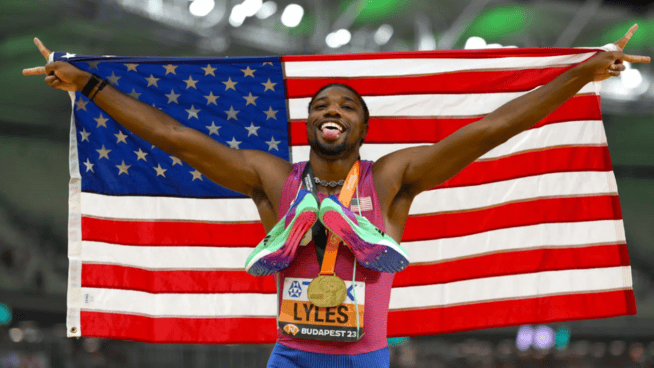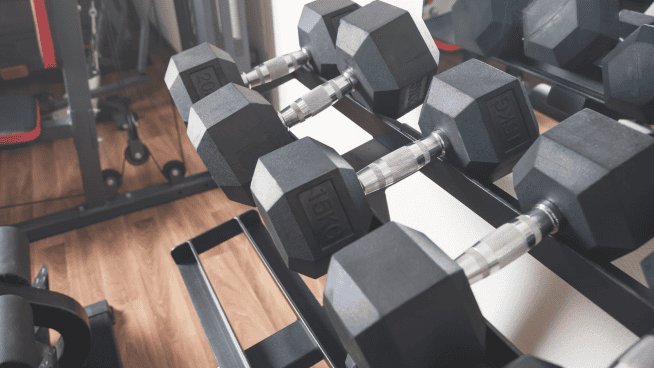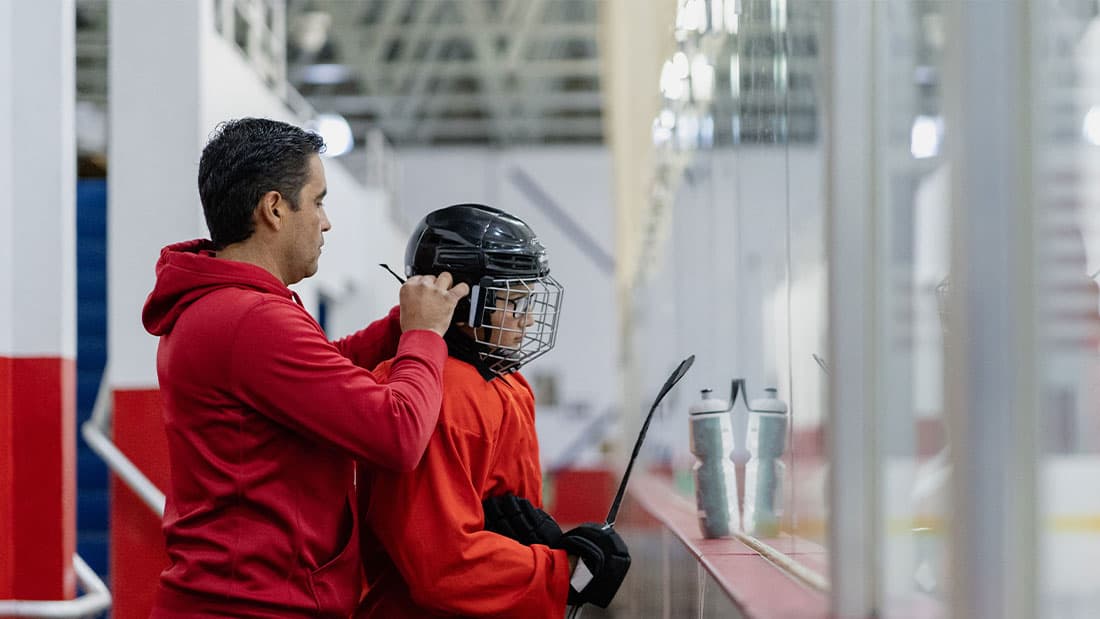Why the Goblet Squat Is the Best Squat for Young Athletes
The Goblet Squat is a lower-body exercise in which you hold a dumbbell or kettlebell with both hands in front of your chest. It’s the ideal Squat variation to teach young athletes proper squat technique; however, it can be used to build strength for everyone.
- Goblet Squat Form
- Goblet Squat Mistakes
- Goblet Squat Benefits
- Goblet Squat Muscles Worked
- Goblet Squat Alternatives and Variations
- Goblet Squat Workouts
Goblet Squat Form
The beauty of the Squat is that it’s incredibly easy to perform—even for beginners and young athletes. Here’s how to do it:
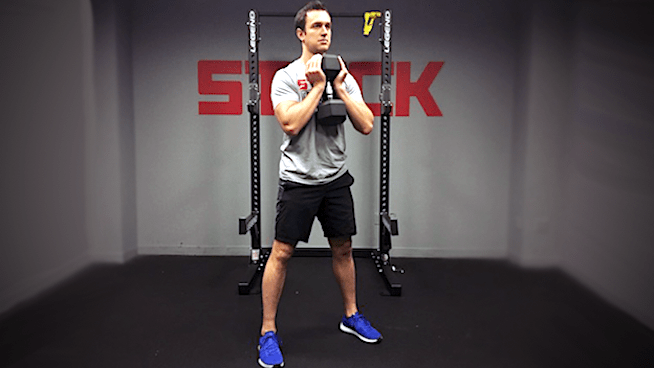
Step 1: Stand with your feet between hip- and shoulder-width apart. Hold a dumbbell or kettlebell vertically with your hands underneath the top of the weight. Hold the weight against your body so it’s touching your sternum and stomach.
Step 2: Keeping your core tight, back flat and dumbbell or kettlebell in contact with your body, bend your hips and knees to initiate the Squat and continue until your elbows touch your knees.
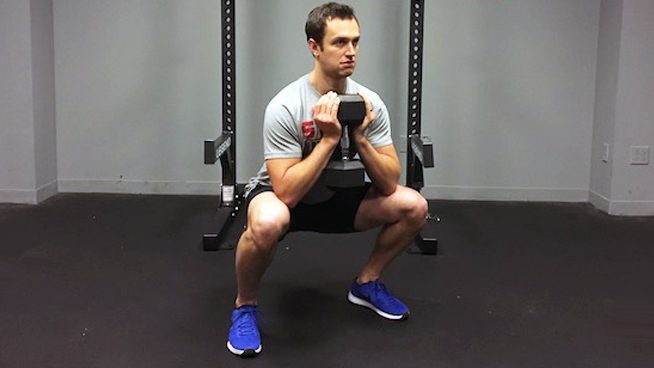
Step 3: Drive your heels into the ground to stand up to the starting position.
Goblet Squat Mistakes
The GS is fairly mistake-proof, which is one thing that makes it such a great exercise. However, there are two common mistakes you need to avoid to perform the move in perfect form.
Mistake 1: Your torso tilts forward
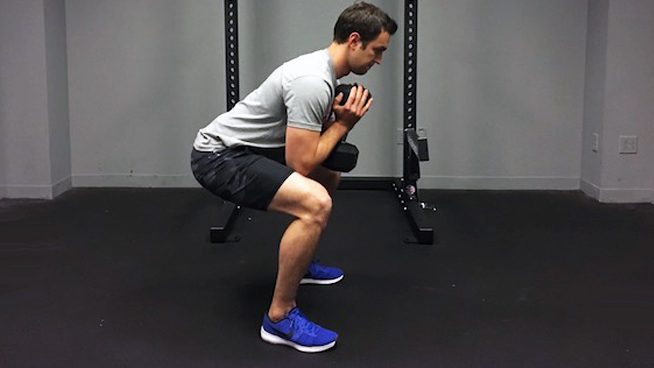
Mike Boyle, renowned strength coach and co-founder of Mike Boyle Strength and Conditioning, explains that if your torso tilts forward during the Squat, that’s an indication that your ankles are too tight or your core isn’t strong enough. You can tell if you tilt too far forward if the bottom portion of the dumbbell comes off your stomach.
The Fix: There are two quick fixes. First, consciously tighten your core and keep the dumbbell in contact with your stomach throughout the rep. Second, place a 5- or 10-pound plate under your heels to overcome any ankle mobility problem.
But these are short-term fixes. You need a long-term plan to develop your core strength. Our 27 Best Core Exercises for Athletes is a great place to start. Also, make ankle mobility training a priority.
Mistake 2: Your knees collapse inward
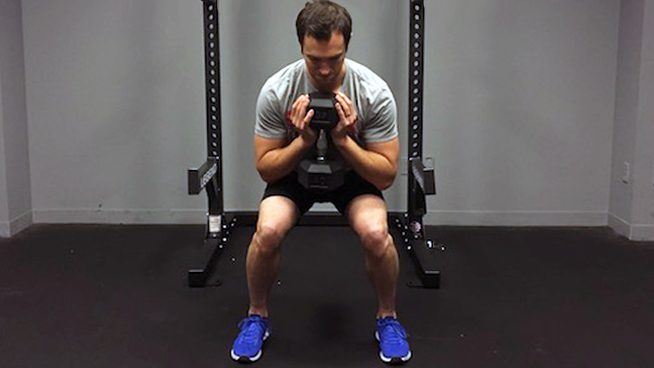
One of the worst mistakes you can make during a Squat is to allow your knees to collapse inward. Technically called valgus collapse, this technique flaw puts your knees at risk during the exercise. Worse, there’s a good chance your knees also do this in dynamic movements in your sport, such as when you land from a jump when you’re more susceptible to an injury.
The Fix: Wrap a lightweight mini-band around your shins just below your knees. The tension from the band engages your glutes and teaches you to push your knees outward so they’re in line with your hips and ankles.
Goblet Squat Benefits
The GS develops lower-body strength, size, and power similar to other versions of the Squat. However, it has a few unique benefits compared to the Back Squat and Front Squat.
It Teaches Proper Squat Form
The Goblet Squat is the perfect option for an athlete learning how to squat. Someone who has little experience in the weight room can be confident they’re squatting with at least decent form if they can keep the weight in contact with their sternum and stomach, and their elbows touch their knees. If not, the fixes are relatively easy, as described above.
“The cool thing about this . . . sometimes it almost immediately cleans things up. It’s almost magical,” says Boyle. “We took a bunch of kids who were not good squatters and said, ‘OK let’s just Goblet Squat,’ and 90 percent of those kids got better right away.”
It’s Easy on Your Back
If Back Squats are uncomfortable or hurt your back, then Goblet Squats are a great option. The goblet position shifts the load to the front of your core and allows for a more upright torso position, which is easier on the spine. In fact, they can also be considered a weighted core exercise, because your abs, obliques, and other core muscles have to engage to perform the exercise properly.
It Can Be Loaded Heavy
Many athletes and coaches make the mistake of categorizing Goblet Squats as beginner exercises and only do them with lightweight. Yes, it’s a great teaching exercise but that doesn’t mean you can’t go heavy. You will ultimately be limited by how heavy the dumbbells are in your gym, but feel free to load up on the weight and challenge yourself. Even strong athletes who regularly Back Squat hundreds of pounds can benefit from heavy Goblet Squats.
Muscles Worked
The Goblet Squat promotes muscle engagement similar to other variations of the Squat. The prime movers are the glutes and quads, but other muscles in the lower body also contribute to the movement.
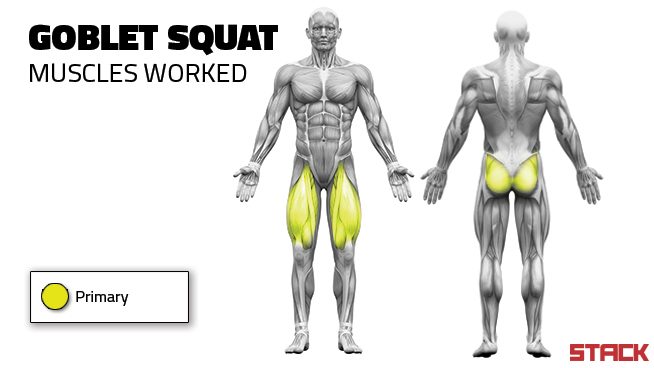
Goblet Squat Alternatives and Variations
Kettlebell Goblet Squat
Holding a kettlebell is similar to a dumbbell, but it doesn’t provide the same feedback as the two contact points. However, it’s still a highly effective exercise.
Squat to Curl
Performing a Curl at the bottom of each rep provides a huge challenge for your core muscles and teaches you to engage them during a Squat, which adds strength to the movement while protecting your spine.
Goblet Rear-Foot-Elevated Split Squat
The Rear-Foot-Elevated Split Squat develops single-leg strength and is an effective exercise to continue challenging yourself if your gym doesn’t have heavy dumbbells.
Goblet Squat Workouts
Goblet Squat Workout
1) Goblet Squats – 4×10
Goblet Squat Superset
1A) Goblet Squats – 4×8
1B) Hamstring Curls – 4×12
Full-Body Workout With Goblet Squats
1) Goblet Squat – 5×5
2A) Inverted Row – 4×8
2B) Half-Kneeling Overhead Press – 4×8 each arm
3A) Single-Leg RDL – 3×8 each leg
3B) Lateral Raises – 3×15
4) Pallof Press – 4×10 each side
RELATED:
RECOMMENDED FOR YOU
MOST POPULAR
Why the Goblet Squat Is the Best Squat for Young Athletes
The Goblet Squat is a lower-body exercise in which you hold a dumbbell or kettlebell with both hands in front of your chest. It’s the ideal Squat variation to teach young athletes proper squat technique; however, it can be used to build strength for everyone.
- Goblet Squat Form
- Goblet Squat Mistakes
- Goblet Squat Benefits
- Goblet Squat Muscles Worked
- Goblet Squat Alternatives and Variations
- Goblet Squat Workouts
Goblet Squat Form
The beauty of the Squat is that it’s incredibly easy to perform—even for beginners and young athletes. Here’s how to do it:

Step 1: Stand with your feet between hip- and shoulder-width apart. Hold a dumbbell or kettlebell vertically with your hands underneath the top of the weight. Hold the weight against your body so it’s touching your sternum and stomach.
Step 2: Keeping your core tight, back flat and dumbbell or kettlebell in contact with your body, bend your hips and knees to initiate the Squat and continue until your elbows touch your knees.

Step 3: Drive your heels into the ground to stand up to the starting position.
Goblet Squat Mistakes
The GS is fairly mistake-proof, which is one thing that makes it such a great exercise. However, there are two common mistakes you need to avoid to perform the move in perfect form.
Mistake 1: Your torso tilts forward

Mike Boyle, renowned strength coach and co-founder of Mike Boyle Strength and Conditioning, explains that if your torso tilts forward during the Squat, that’s an indication that your ankles are too tight or your core isn’t strong enough. You can tell if you tilt too far forward if the bottom portion of the dumbbell comes off your stomach.
The Fix: There are two quick fixes. First, consciously tighten your core and keep the dumbbell in contact with your stomach throughout the rep. Second, place a 5- or 10-pound plate under your heels to overcome any ankle mobility problem.
But these are short-term fixes. You need a long-term plan to develop your core strength. Our 27 Best Core Exercises for Athletes is a great place to start. Also, make ankle mobility training a priority.
Mistake 2: Your knees collapse inward

One of the worst mistakes you can make during a Squat is to allow your knees to collapse inward. Technically called valgus collapse, this technique flaw puts your knees at risk during the exercise. Worse, there’s a good chance your knees also do this in dynamic movements in your sport, such as when you land from a jump when you’re more susceptible to an injury.
The Fix: Wrap a lightweight mini-band around your shins just below your knees. The tension from the band engages your glutes and teaches you to push your knees outward so they’re in line with your hips and ankles.
Goblet Squat Benefits
The GS develops lower-body strength, size, and power similar to other versions of the Squat. However, it has a few unique benefits compared to the Back Squat and Front Squat.
It Teaches Proper Squat Form
The Goblet Squat is the perfect option for an athlete learning how to squat. Someone who has little experience in the weight room can be confident they’re squatting with at least decent form if they can keep the weight in contact with their sternum and stomach, and their elbows touch their knees. If not, the fixes are relatively easy, as described above.
“The cool thing about this . . . sometimes it almost immediately cleans things up. It’s almost magical,” says Boyle. “We took a bunch of kids who were not good squatters and said, ‘OK let’s just Goblet Squat,’ and 90 percent of those kids got better right away.”
It’s Easy on Your Back
If Back Squats are uncomfortable or hurt your back, then Goblet Squats are a great option. The goblet position shifts the load to the front of your core and allows for a more upright torso position, which is easier on the spine. In fact, they can also be considered a weighted core exercise, because your abs, obliques, and other core muscles have to engage to perform the exercise properly.
It Can Be Loaded Heavy
Many athletes and coaches make the mistake of categorizing Goblet Squats as beginner exercises and only do them with lightweight. Yes, it’s a great teaching exercise but that doesn’t mean you can’t go heavy. You will ultimately be limited by how heavy the dumbbells are in your gym, but feel free to load up on the weight and challenge yourself. Even strong athletes who regularly Back Squat hundreds of pounds can benefit from heavy Goblet Squats.
Muscles Worked
The Goblet Squat promotes muscle engagement similar to other variations of the Squat. The prime movers are the glutes and quads, but other muscles in the lower body also contribute to the movement.

Goblet Squat Alternatives and Variations
Kettlebell Goblet Squat
Holding a kettlebell is similar to a dumbbell, but it doesn’t provide the same feedback as the two contact points. However, it’s still a highly effective exercise.
Squat to Curl
Performing a Curl at the bottom of each rep provides a huge challenge for your core muscles and teaches you to engage them during a Squat, which adds strength to the movement while protecting your spine.
Goblet Rear-Foot-Elevated Split Squat
The Rear-Foot-Elevated Split Squat develops single-leg strength and is an effective exercise to continue challenging yourself if your gym doesn’t have heavy dumbbells.
Goblet Squat Workouts
Goblet Squat Workout
1) Goblet Squats – 4×10
Goblet Squat Superset
1A) Goblet Squats – 4×8
1B) Hamstring Curls – 4×12
Full-Body Workout With Goblet Squats
1) Goblet Squat – 5×5
2A) Inverted Row – 4×8
2B) Half-Kneeling Overhead Press – 4×8 each arm
3A) Single-Leg RDL – 3×8 each leg
3B) Lateral Raises – 3×15
4) Pallof Press – 4×10 each side
RELATED:







